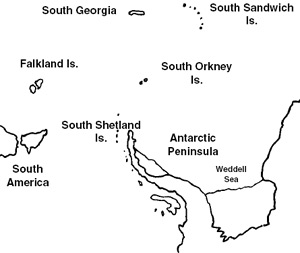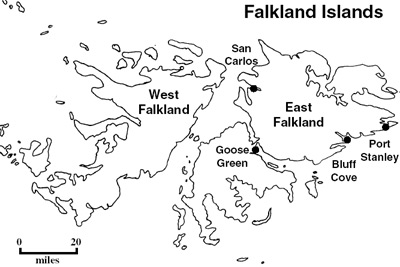
| Glasgow Digital Library | Voyage of the Scotia | BRUCE | PEOPLE | SHIP | ANTARCTIC | INDEX |
|---|
The Falkland Islands have been claimed by Spain, France, Argentina and the United Kingdom. They may have been sighted by the Italian (later Spanish) navigator Amerigo Vespucci, but the first official sighting was by the British navigator John Davis in 1592. In 1600 the Dutchman Sebald de Wert sighted West Falkland. In 1698-1690 the English Captain Strong sailed between East and West Falkland naming the sound Falkland Sound (which later became the name of the islands).
Before the 18th century the islands remained uninhabited. The first map of the Falkland Islands was published by the French in 1716. In 1764 the French under Antoine de Bougainville founded a settlement on East Falkland and built Fort Louis. The French called the islands Illes Malouines (the original Spanish name was Islas do Sanson). The same year Captain John Byron (grandfather of the poet Lord Byron) had landed on West Falkland and claimed the islands for the British. In 1766 Bougainville sold the island to Spain (who already claimed the islands) for £250,000.
Meanwhile the British had a settlement - not always occupied - at Port Egmont on West Falkland.

In 1820 a frigate from the new republic of Buenos Aires (later Argentina) took possession of the island, installed a governor in 1823 and landed 90 colonists in 1826. In 1831 the Argentinian government arrested two American schooners for fishing in Argentinian waters off the Falkland Islands. On the journey to Buenos Aires they were released by an American corvette which then razed the fort at Fort Louis (now called Puerto del Soledad) to the ground and took a large number of prisoners.
In 1833 the British took over the islands (called Las Malvenas by the Spanish) and have governed there ever since. Argentina not only claimed the Falklands Islands but also South Georgia, the South Sandwich Islands, the South Orkney and South Shetland Islands and the Antarctic Peninsula.
Britain and Argentina were both signatories of the Antarctic Treaty in 1961 which laid aside claims for land south of 60°S. This did not include the Falkland Islands, South Georgia and the South Sandwich Islands.
In 1982 the Argentinian dictator Leopoldo Galtieri decided to invade the Falkland Islands. The British appeared to have less interest in the islands - they had ignored the new Argentinian base on South Thule, appeared not too concerned about the Argentinian scrap metal dealers dismantling the whaling base at Leith on South Georgia and intended to withdraw the only Royal Navy ship in the area, Endurance.
South Georgia and the Falkland Islands were invaded on 2 April 1982. Only a token resistance was made (although on South Georgia a small party of marines shot down two Argentinian helicopters and holed a frigate - they surrendered when the frigate fired back). One of the Argentinian ships involved was Bahia Paraiso, a scientific survey vessel.
The British decided to retake the islands and assembled a task force of 100 ships which included two aircraft carriers (essential to the success of the war) and the passenger liners Canberra and Queen Elizabeth 2.

South Georgia was retaken on 25 April, but it was 21 May before a British force landed at San Carlos on the west side of East Falkland.
The British forces were constantly attacked by Argentinian aircraft from mainland Argentina. Harrier jets and anti-aircraft missiles were the main defence. The loss of some of the large helicopters on the container ship Atlantic Conveyor meant that most of the troops had to march across East Falkland. On 14 June the British troops marched into Port Stanley and the Argentinian forces surrendered.
The British lost 250 men and the Argentinians about 1,000. The British lost seven ships to Argentinian aircraft - two destroyers, two frigates, one container ship and two fleet supply ships (in which 51 were killed and 43 injured at Bluff Cove - the worst British disaster of the war). A total of 368 lives were lost on the Argentinian cruiser Belgrano, sunk by a British submarine.
There is a permanent military force now in the Falkland Islands. A large airport has been established at Mount Pleasant west of Port Stanley and there are regular flights to the United Kingdom (refuelling on Ascension Island).
The British Antarctic Survey has a supply base at Port Stanley and most of their personnel fly into Port Stanley before going south to Rothera by ship or by Dash 7, the British Antarctic Survey plane.
| Glasgow Digital Library | Voyage of the Scotia | BRUCE | PEOPLE | SHIP | ANTARCTIC | INDEX |
|---|